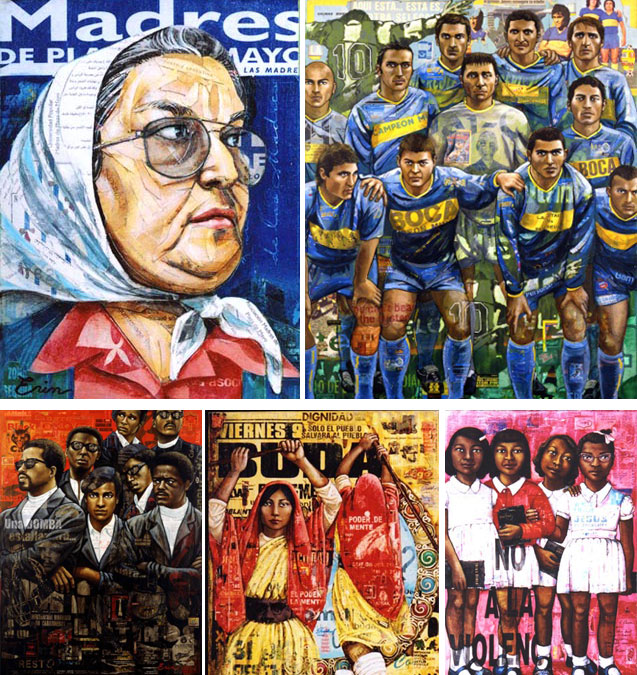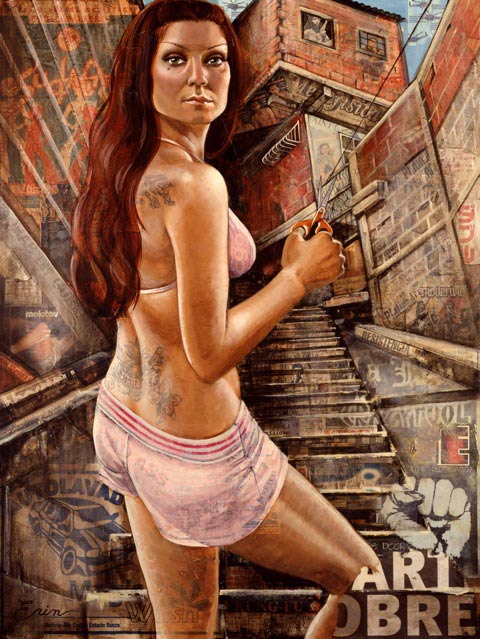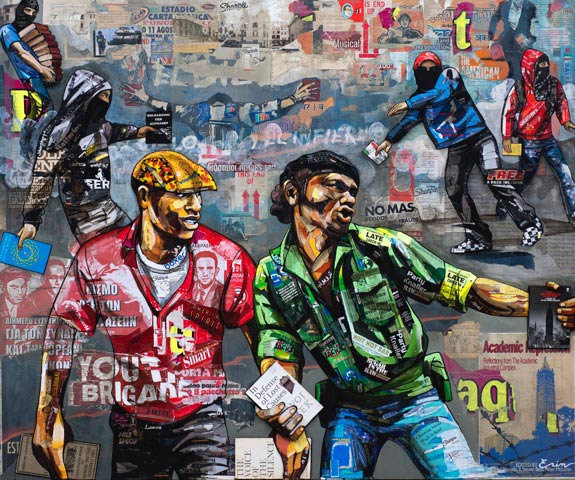
Support justice-driven, accurate and transparent news — make a quick donation to Truthout today!
Erin Currier’s simple art studio, located within an unassuming adobe compound in Santa Fe, New Mexico, is not what one would expect for the first artist (and US citizen) to have had a solo show at the Embassy Republica Bolivaria de Venezuela in Washington, DC. Nor would one guess that her work was included in the collections of the likes of the late President Hugo Chavez, Lisa Bonet, John and Joan Cusack, Julia Roberts and Carlos Santana.
Currier’s eyes, that are simultaneously exploring and absorbing, are fitting for someone as knowledgeable and confident, yet humble, as she is. Her work, which is also an important part of her political activism, is obviously well known in the art sphere by major collectors, as well as major political figures and activists intent on changing the current global paradigm of repression and exploitation.
As the philosopher Slavoj Zizek succinctly puts it: “Who needs direct repression when one can convince the chicken to walk freely into the slaughterhouse?”
The work of Erin Currier is designed as a tribute to the underprivileged and disenfranchised of the world – those left on the lower end of the exponential gap between the haves and have-nots, those fighting against the rapaciousness of modern-day neoliberalism.
From Angela Davis to Howard Zinn to Wangari Maathai to waiters and workers and bathroom cleaners, Currier extols those who are both impacted by, and standing up against, the machine. She and her partner, writer, poet, artist and intellectual Anthony Hassett, make annual pilgrimages to slums, ghettos and barrios all over the world, where she collects garbage scraps, shreds of paper and consumer waste while meeting people who will find their way onto her canvases in Santa Fe. Currier sends her gatherings back to her studio where she eventually transforms them into portraits of the dispossessed. For her, the medium is the message: her subjects, like the scraps she uses, have been discarded by the system, and Currier’s decision to stop, bend over, pick up and transform these scraps, to celebrate the dispossessed, is her own kind of resistance. Currier then works to “resell the trash in the form of fine art for funds with which to travel again,” thereby creating her “reversed Robin Hood form of recycling.”
In addition to recycling consumer waste into powerfully beautiful and politically poignant works of art, Currier’s work reminds us both of what we are all up against as well as that essential need to be living lives of resistance. Her subjects challenge us to work toward justice, equality and true liberation, while her work invokes us to, as Hassett has written, become part of Currier’s “descriptions of physical environments with penetrating glimpses of psychology, vulnerability, and strength.”
Truthout interviewed Currier about her work, her thoughts on revolution, slowness, life and dreams.
Dahr Jamail: You have travelled much of the world. But, rather than leisure, you’ve intentionally sought out places the mainstream sightseer pays money to avoid: barrios, ghettos, slums, worker compounds. Why?
Erin Currier: What is most important to me is to see, firsthand, how people live and what the day-to-day existence is like for the majority of people in the country I am visiting. As you know, this is best achieved (whether by you, the journalist, or me, the renderer), by living as people live to the best of one’s ability: travelling on foot, by local bus, or city train; renting a humble place where one can cook and buy produce at nearby markets; attending language courses; making friends. I have never been content in, accepting at face value, that which the mainstream media and the government of my country tell me in regards to a place and its people. Travelling to places has proved how biased and one-dimensional such information can be. For example: Growing up in the rural USA, and relying on major networks and popular magazines for news, one could easily come to the conclusion that south of the Mexican border is one vast jungle of narcotraffickers. However, when one travels to Central and South America, one instead encounters a place of rich cultural variation – with myriad languages, musical and theatrical traditions, religions, music, dance. Every ethnicity, as well as every natural ecosystem, is represented.
My first six-month journey through South America in 2003 inspired a series of works that expressed the above. The series, titled “The Other America,” paid homage to Americans south of the Mexican border with diverse works such as: “Las Madres de La Plaza de Mayo,” “Boca Juniors,” “Black Panthers,” “Pueblo Women,” and “Cynthia, Carol, Denise, and Addie Mae.”
 Clockwise from top left: “Las Madres de La Plaza de Mayo,” “Boca Juniors,” “Black Panthers,” “Pueblo Women,” “Cynthia, Carol, Denise, and Addie Mae.”(Photos: D’Nelle Garcia, Blue Rain Gallery)
Clockwise from top left: “Las Madres de La Plaza de Mayo,” “Boca Juniors,” “Black Panthers,” “Pueblo Women,” “Cynthia, Carol, Denise, and Addie Mae.”(Photos: D’Nelle Garcia, Blue Rain Gallery)
The underlying theme of this work, and of all of my work, is that which I continue to find to be true wherever I have travelled – be it Latin America, Africa, the Middle East, Asia or Europe: that our commonalities as human beings far outweigh our differences. The overwhelming majority of people I have met all over the world are warm, kind, decent human beings whose needs are simple and universal: adequate shelter, food, clean water, the ability to raise and provide for a family, the ability to make use of one’s particular set of skills, etc.
Prior to your chosen form of art, did you use a different media? If so, what was it, and what led you into your current form? You collect “post-consumer waste” from abroad, then bring it to your studio to create works by tearing it into useable pieces . . . an amazing metaphor of a possible post-neoliberal world . . . talk more about how this process came into being for you.
My mother introduced me to drawing, painting, collage, and other art forms, as soon as I could hold a crayon. She and my father quickly realized that I could be taken anywhere and would behave, so long as I had markers and paper. I was always the class artist – the “go to” for any poster, banner, program, etc., that needed to be created. In my early twenties, I was working in a coffee shop – a job that afforded me time to paint. It was something of a revelation to see the amount of trash thrown away there in a single morning. I was equally struck by the ornate beauty of the packaging and debris itself: the jewel-toned tea wrappers, the lotus-like boxes, the alluring pink swirl on the half and half container. So much creative energy and natural resources are used in the service of creating these works of Warholpian commodity art – only for it to be thrown away en masse. I began collecting it all, and I created a series of Buddhist deities. I was studying Tibetan Thangka painting and practicing Buddhist meditation at the time. The idea of impermanence seemed embodied in coffee shop refuse itself; the Buddhist idea of transformation of negative into positive through awareness and work – was one I put into action by taking discarded waste and transforming it into art.
In the years that followed, I was able to use the proceeds of my art to travel the world. I searched for examples of ancient Buddhist ideals, compassion and action, and found these ideals embodied in the form of civil rights leaders such as Septima Clark, Bob Moses, Angela Davis, and in social movements across the world. I collected post-consumer waste in every country I visited, and embarked upon a Robin Hood form of recycling, in which the proceeds of my work sold in the “first world” were utilized in travel to the “third world” where I’d gather more trash, mail it to my studio, parlay it into art and essentially resell the trash in the form of fine art for funds with which to travel again.
You’ve periodically created self-portraits, casting yourself as one of your own subjects. Talk a little about this.
I create a self-portrait every year or two – both as an archive of where I am at philosophically, and to express the fact that I empathize and identify with the people I portray. “Self Portrait 2011,” “2007,” “2004,” and “Me, Myself, and I, In Solidarity With Venezuela,” all particularly exemplify the latter.
 “Self Portrait 2011.” (Photo: D’Nelle Garcia, Blue Rain Gallery)
“Self Portrait 2011.” (Photo: D’Nelle Garcia, Blue Rain Gallery)
 “Self Portrait 2007.” (Photo: D’Nelle Garcia, Blue Rain Gallery)
“Self Portrait 2007.” (Photo: D’Nelle Garcia, Blue Rain Gallery)
 “Self Portrait 2004.” (Photo: D’Nelle Garcia, Blue Rain Gallery)
“Self Portrait 2004.” (Photo: D’Nelle Garcia, Blue Rain Gallery)
 “Me, Myself and I, In Solidarity With Venezuela.” (Photo: D’Nelle Garcia, Blue Rain Gallery)
“Me, Myself and I, In Solidarity With Venezuela.” (Photo: D’Nelle Garcia, Blue Rain Gallery)
I share a deep affinity with many of the workers, women, poets, civil rights activists and others, whom I have portrayed in works such as “Bush International Bathroom Attendant,” “Nogales,” “Las Madres de Los Sandinistas,” “Temple Cleaners of Cambodia,” and “Tuk-Tuk Gaucho.”
 “Bush International Bathroom Attendant.” (Photo: D’Nelle Garcia, Blue Rain Gallery)
“Bush International Bathroom Attendant.” (Photo: D’Nelle Garcia, Blue Rain Gallery)
 “Nogales.” (Photo: D’Nelle Garcia, Blue Rain Gallery)
“Nogales.” (Photo: D’Nelle Garcia, Blue Rain Gallery)
 “Las Madres de Los Sandinistas.” (Photo: D’Nelle Garcia, Blue Rain Gallery)
“Las Madres de Los Sandinistas.” (Photo: D’Nelle Garcia, Blue Rain Gallery)
 “Temple Cleaners of Cambodia.” (Photo: D’Nelle Garcia, Blue Rain Gallery)
“Temple Cleaners of Cambodia.” (Photo: D’Nelle Garcia, Blue Rain Gallery)
 “Tuk-Tuk Gaucho.” (Photo: D’Nelle Garcia, Blue Rain Gallery)
“Tuk-Tuk Gaucho.” (Photo: D’Nelle Garcia, Blue Rain Gallery)
I believe that my art plays a role, however small, in international movements for social justice. For me, art is work, art is spiritual practice, art is poetry, and art is a necessary element of every struggle, and of every revolution. Above all, the self-portraits are meant to convey this spirit of solidarity.
Your work is intensely precise, but a precision borne of fragmentation, tearing, refuse, randomness, perhaps both patience and impatience . . . deliberate but ultimately based on chance. Your art is beauty against a backdrop of degradation, barbarism, and apocalyptic economics and global anthropogenic climate disruption. Is this process the same, a mimicking of what you hope to see in the revolutions and movements you are chronicling?
The work is less about “what I hope to see” and rather what I do see: beauty inherent in struggle, resistance and defiance, up against the catastrophic onslaught of globalization, capitalism, fascism and ecological devastation. I see our reality as in a state of becoming. I see myself as one of many people working (with both patience and impatience – as you noted!) with the skills at hand – be it art-making, planting seeds, penning words, educating, organizing – in a limiting present reality that I am critically objective of, yet that I acknowledge as a historical reality susceptible to transformation. Through reflection and action, human beings can truly transform reality – my partner and I were witness to it in Egypt just weeks after Mubarak was ousted: The people of Cairo were directing traffic, cleaning the streets; young people were gathering mandates in order to draft a new constitution.
“Egyptian Women” was informed by our time there, as was “Leila: Sphinx Bathroom Attendant.”
 “Egyptian Women.” (Photo: D’Nelle Garcia, Blue Rain Gallery)
“Egyptian Women.” (Photo: D’Nelle Garcia, Blue Rain Gallery)
 “Leila: Sphinx Bathroom Attendant.” (Photo: D’Nelle Garcia, Blue Rain Gallery)
“Leila: Sphinx Bathroom Attendant.” (Photo: D’Nelle Garcia, Blue Rain Gallery)
In Egypt, there was a moment – a window in which an imaginative counter-power prevailed, as in Nicaragua before it, and South Africa, Iran, Cuba, Russia, France. It is the moment worth struggling toward – a moment of humanization and solidarity. The global economic system, in its capitalist form, purports to be an implacable, unchanging, inevitable reality. Yet, like everything else, it is subject to being overhauled, overthrown, transformed – as I’ve depicted in works such as “Attica Schoolboys,” “The Event of Literature” and “Volver” – should people reflect upon it critically, and then decide how to take action.
 “Attica Schoolboys.” (Photo: D’Nelle Garcia, Blue Rain Gallery)
“Attica Schoolboys.” (Photo: D’Nelle Garcia, Blue Rain Gallery)
 “The Event of Literature.” (Photo: D’Nelle Garcia, Blue Rain Gallery)
“The Event of Literature.” (Photo: D’Nelle Garcia, Blue Rain Gallery)
 “Volver.” (Photo: D’Nelle Garcia, Blue Rain Gallery)
“Volver.” (Photo: D’Nelle Garcia, Blue Rain Gallery)
Talk more about the role of art in revolution, transformation and shifting consciousness. In today’s digital world where exponential increases in the rapidity of information dissemination finds most people breathlessly trying to keep up with even just their email, how can art give us pause? Talk about why art and slowness are more important than ever.
We are conditioned and even encouraged to feel separate and alienated from the “Other.” Art has the potential to make the viewer aware of, to question, and perhaps to even let go of, his or her own prejudices. For example, inevitably, some of the viewers of my “American Schoolgirls” series (portraying Muslim American, Chinese American, and Native American female students) will ask, “What country are those girls from?”
 “American Schoolgirls.” (Photo: D’Nelle Garcia, Blue Rain Gallery)
“American Schoolgirls.” (Photo: D’Nelle Garcia, Blue Rain Gallery)
The question reveals our deep-seeded assumptions about race, ethnicity, religion, etc. Another example of how my work seeks to compel the viewer to recognize our “sameness” as opposed to our “otherness” is “Uighurs in Bermuda.” This piece depicts four guys on a beach who could be any viewers’ own nephew, uncle, brother, son or longtime pal – be that viewer from Jersey City, Rio de Janiero, Paris, Panama City or Albuquerque.
 “Uighurs in Bermuda.” (Photo: D’Nelle Garcia, Blue Rain Gallery)
“Uighurs in Bermuda.” (Photo: D’Nelle Garcia, Blue Rain Gallery)
Upon further investigation, however, the viewer finds out that the Uighurs are ethnic Chinese Muslims who fled China, found employment as laborers first in Pakistan, then Afghanistan – where they were sold out to US military as “terrorists” (the military were paying desperately poor civilian informants to turn in anyone suspected of terrorist activities) – and then on to Guantánamo Bay, where they were held for many years, because, although they were quickly found to be innocent of terrorist activity by the US military, no country in the world would offer these Uighurs asylum. Albania finally accepted 17 of the men; Bermuda eventually accepted the four I portrayed. Art has the potential to make people aware of stories such as the above, that might otherwise get lost in cyberspace. In this way, my work is an homage to, and a visual archive of, the lives and stories of individuals, some of whom are little known – so that they may be acknowledged and remembered in the same way that historical portraiture has allowed us to recognize aristocrats and kings.
Periodically during my work as a war journalist and chronicler of global anthropogenic climate disruption I experience periods of extreme burnout, depression, nihilism. Do you experience the same, and if so, what role does your art play in your own therapy?
I cannot purport to have seen and experienced anything near what you have seen and experienced, however, I empathize with your sentiments. My low periods are rare, and characterized by a sense of futility – by a feeling that I should do more: that art is not enough. But then I recall the many incidents in which art has been covered, concealed or destroyed by repressive regimes; in which artists have been detained, imprisoned, even tortured and killed; or in which art has educated, inspired inquiry and action, even propagated revolution. All of this attests to art’s socially transformative potential. On a personal level, I feel fortunate to be able to transform the trash on the street, as well as the rage and sadness I feel upon encountering injustice, into something of beauty. The stories of “Abdulrahman Al-Awlaki,” and of “Esequiel Hernandez,” (both underage US citizens who were killed by the US military), for instance, moved me to tears and enraged me: I used this as fuel for the fire of the creation of portraits of both boys.
 “Abdulrahman Al-Awlaki.” (Photo: D’Nelle Garcia, Blue Rain Gallery)
“Abdulrahman Al-Awlaki.” (Photo: D’Nelle Garcia, Blue Rain Gallery)
 “Esequiel Hernandez.” (Photo: D’Nelle Garcia, Blue Rain Gallery)
“Esequiel Hernandez.” (Photo: D’Nelle Garcia, Blue Rain Gallery)
It was my own small act of defiance against the two assassinations, and an assertion of the value of their lives . . .
What keeps me making art, aside from the fact that it is akin to breathing, and brings me satisfaction and joy, is the knowledge of the many people I have met all over the world – workers, mothers, journalists, teachers – who are also working toward social transformation – as well as an inner certainty that, as Martin Luther King Jr. stated, “The arc of the universe is long, but it bends towards justice.”
Media that fights fascism
Truthout is funded almost entirely by readers — that’s why we can speak truth to power and cut against the mainstream narrative. But independent journalists at Truthout face mounting political repression under Trump.
We rely on your support to survive McCarthyist censorship. Please make a tax-deductible one-time or monthly donation.